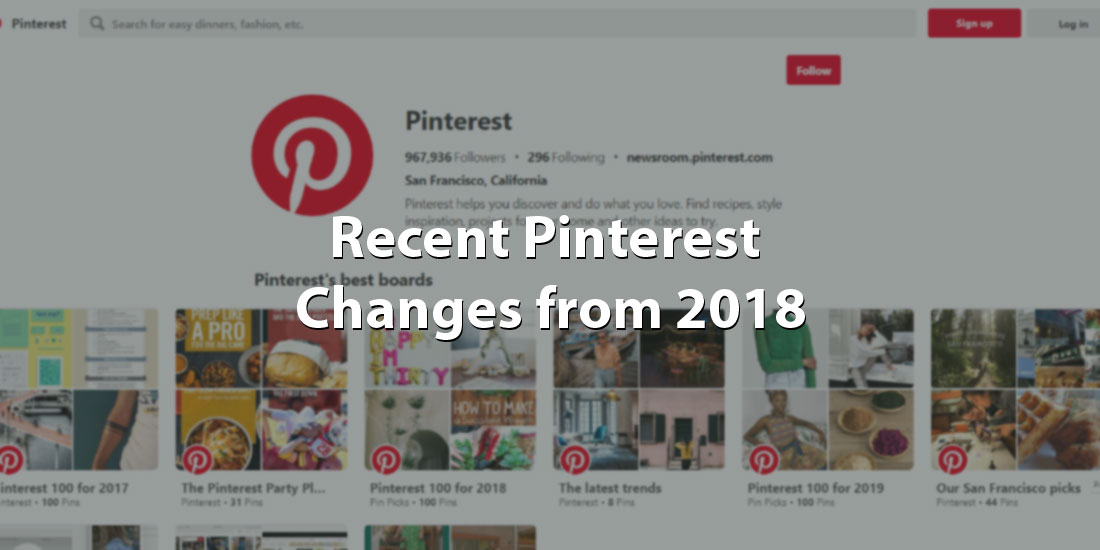The digital landscape is always changing. Websites never stop tweaking their functions, and digital creators need to be observant if they want to keep up with the times. Pinterest recently rolled out an extensive set of updates that changed several aspects of the site. So here’s what has changed, what’s staying the same, and how to stay on top of the game.
Contents
New Features: Cover Images from Latest Pins, Auto Organize Boards
First off, user profiles have undergone some changes; you can now add cover images. Your cover image can come from your latest pins, your recent pins, or specific boards. Another change is that your follower count display has been replaced with a monthly viewer count. You can still view your follower count; it’s just hidden behind a tab. Tabs are also a new feature, the tabs include followers, following, activity, and other displays.
Pinterest has also made it easier to organize your boards, instead of manually dragging your items, you can now automatically sort them based on a variety of criteria. There’s now a whole new feed for users to view, the “following” feed, which displays a chronological feed of pins from accounts you follow.
Less visible, but certainly no less important are the changes to Pinterest’s algorithm. Content will now prioritize content that your followers engage with. Meaning that your followers will determine if your pin appears in feeds or search results. Pinterest also recommends using at least twenty hashtags on every pin you make. This helps your content appear on hashtag feeds. These feeds are meant to show the hottest new content in a specific category. Since these feeds are meant for new content, it won’t be much use to add hashtags onto older posts. Hashtags are most important for timely content that benefits from immediate engagement, like Holiday posts. Thus, for non-time specific content, you won’t need so many hashtags.
To summarize, Pinterest is moving towards chronological feeds, follower engagement is crucial for getting your posts noticed, and new content will get a boost from the algorithm.
What’s Next?
Here’s how Pinterest is going to change things up in the near future. First off, the “follower” tab was initially implemented for a limited set of users; soon it will be given to all Pinterest users. Pinterest will also be adding a “recommended profiles to follow” feature. To get the most out of this feature, you need to pin consistently, have a business account, and have a claimed website.
Your profile will now get recommended to users based on how your followers are engaging with your content. Meaning engagement, close-ups, clicks, saves, comments, etc. will boost your visibility. Unfortunately, Pinterest will be reducing the visibility of group boards, so those who depended on them for distribution will need to focus more on Pinterest SEO. Pins longer than 2:3 ratio or 1260px will now be penalized. They will be made less visible in feeds, especially mobile feeds.
What’s Not Changing?
Here are some things that will not be changing at the moment. For instance, your monthly views will still encapsulate the true reach of your content. Re-pinning content from other users will still help your overall engagement. Also, your board order will not affect the algorithm; it mostly serves an aesthetic purpose. Scheduling your posts automatically will not hurt your engagement. If you’re not a food blogger, you won’t get a boost from turning off Rich Pins, since hiding Rich Pin descriptions in recipes make it more likely for people to click on it since they won’t see anything that’ll immediately turn them off.
In general, the number of followers you have is less important than how much for followers are engaging with your content. It’s also important to have a wide variety of engagement.
Other Important Notes:
- The time a post is made does not totally determine engagement.
- The algorithm will not penalize outside apps.
- Pinterest will be cracking down on spam and content theft.
- You can now flag stolen pins, even if they weren’t stolen from you, as well as reporting entire profiles.
- Make your pins’ description match the post it links to.
- Titles, keywords, and descriptions affect all your pins.
- Pinterest prioritizes pins that link to your website.
What to Do?
- Get a business account.
- Claim your Website
- Edit pins that are too large.
- Find out what your followers engage with and try to cater to their interests.
- Post consistently.
- Don’t stuff in keywords.
- If you need to pivot your content niche, it may be better to start a new account, rather than have your followers bury your content.
- Make sure to place pins in the most relevant boards.


